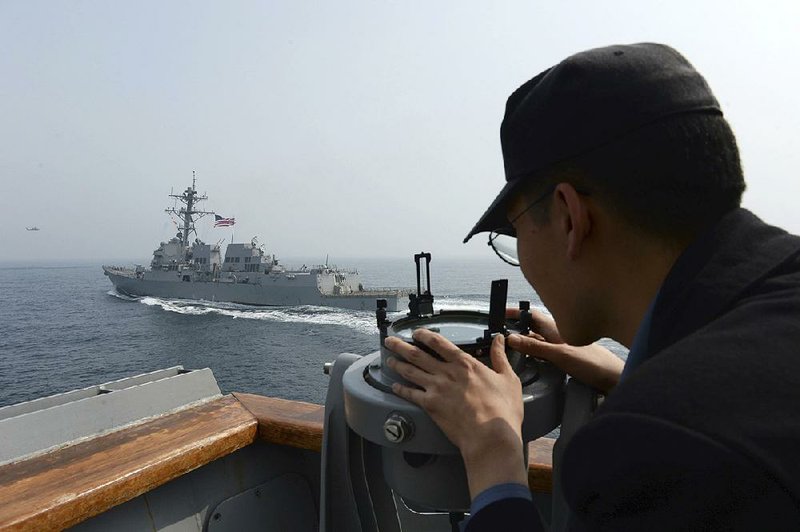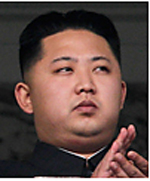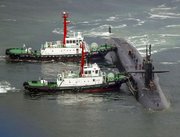HONG KONG -- The United States and South Korea began installing key elements of an advanced missile-defense system in a rural southern area early this morning, a day after North Korea held huge artillery drills to mark the 85th anniversary of the founding of its military.
Work on the Terminal High Altitude Area Defense system got underway in South Korea's Seongju County, 135 miles southeast of Seoul. China, which strongly opposes the missile-defense system, continued to try to tamp down tensions amid signs that North Korea was preparing for a nuclear test.
It remained unclear whether the installation was on schedule; Washington and Seoul have said only that they want the system operational "soon" or "within this year."
North Korea's long-range artillery drills were conducted Tuesday near Wonsan, along the country's east coast, according to the South Korean military. They coincided with military maneuvers by the United States and its allies, as well as the arrival of the USS Michigan, a submarine armed with Tomahawk cruise missiles, in the port city of Busan, South Korea.
The U.S. Navy described the arrival of the submarine as routine, but its presence reflected the heightened military readiness on both sides of the Korean Peninsula.
Later Tuesday, the Navy destroyer USS Wayne E. Meyer began maritime exercises with a South Korean destroyer in the Yellow Sea, west of the Korean Peninsula. Separately, the destroyer USS Fitzgerald was conducting drills with a Japanese destroyer in the Sea of Japan, east of the peninsula. The two exercises were to continue today.
"Both exercises demonstrate a shared commitment to security and stability in Northeast Asia," the U.S. 7th Fleet said in a statement, "as well as the U.S. Navy's inherent flexibility to combine with allied naval forces in response to a broad range of situations."
In addition to holding joint naval exercises in the Yellow Sea, the United States and South Korea have been staging military maneuvers in Pocheon, northeast of Seoul, demonstrating some of their latest weapons. A North Korean state newspaper said last week that the joint maneuvers were taking the tense situation on the peninsula to the "verge of explosion."
North Korea often uses important national holidays, like the anniversary Tuesday, to display its military might. On April 15 -- the 105th birthday of Kim Il Sung, the country's founder -- the North staged a large military parade, flaunting what analysts said could be new intercontinental ballistic missiles. The next morning, it launched a ballistic missile that failed after liftoff.
The lack of a nuclear or long-range missile test as of Tuesday afternoon led to speculation that Kim Jong Un, the leader of the country, had instead decided to celebrate the anniversary with a large demonstration of conventional weapons.
"We are closely watching the North Korean military's movements around Wonsan while maintaining a firm preparedness," the South Korean military said in a statement.
The South Korean news agency Yonhap, citing an unidentified government source, said the exercise involved 300 to 400 pieces of long-range artillery, of the same type deployed along the border north of Seoul. Seoul, a city of 10 million, lies in range of the North Korean artillery.
Yonhap called the drill one of the largest live-fire exercises conducted by the North.
On Tuesday, China dispatched Wu Dawei, a longtime diplomat handling tensions on the Korean Peninsula, to Tokyo for talks with Japanese Foreign Ministry officials, in hopes of warding off military confrontation.
China, an ally of North Korea that has become increasingly impatient with its behavior, has tried to play a mediating role; its president, Xi Jinping, speaking by phone with President Donald Trump on Monday, cautioned restraint. The question is whether Beijing has enough leverage to avert a detonation at the North's atomic test site in Punggye-ri, where, analysts say, preparations for a blast appear to have recently resumed.
As Wu traveled to Japan, the Chinese state media defended how Beijing had handled the latest tensions. The Global Times, a widely read tabloid, praised Chinese coordination with the Trump administration but said the key to defusing the tensions was in the hands of the United States, not China.
"China's influence over the entire situation is very limited," an editorial in the paper said Tuesday. "The United States hopes that China can be like a magician managing Pyongyang's nuclear activities, while Pyongyang hopes that Beijing will apply its pressure against the threat of war from the United States and South Korea. In the end, China can't make either side entirely happy."
Today, U.S. Secretary of State Rex Tillerson and Defense Secretary James Mattis are to brief the entire Senate at the White House on North Korea. The briefing will also include Dan Coats, the director of national intelligence, and Joseph Dunford Jr., the chairman of the Joint Chiefs of Staff, said Sean Spicer, the White House spokesman.
Information for this article was contributed by Chris Buckley and Su-Hyun Lee of The New York Times and by Anna Fifield of The Washington Post.
A Section on 04/26/2017


